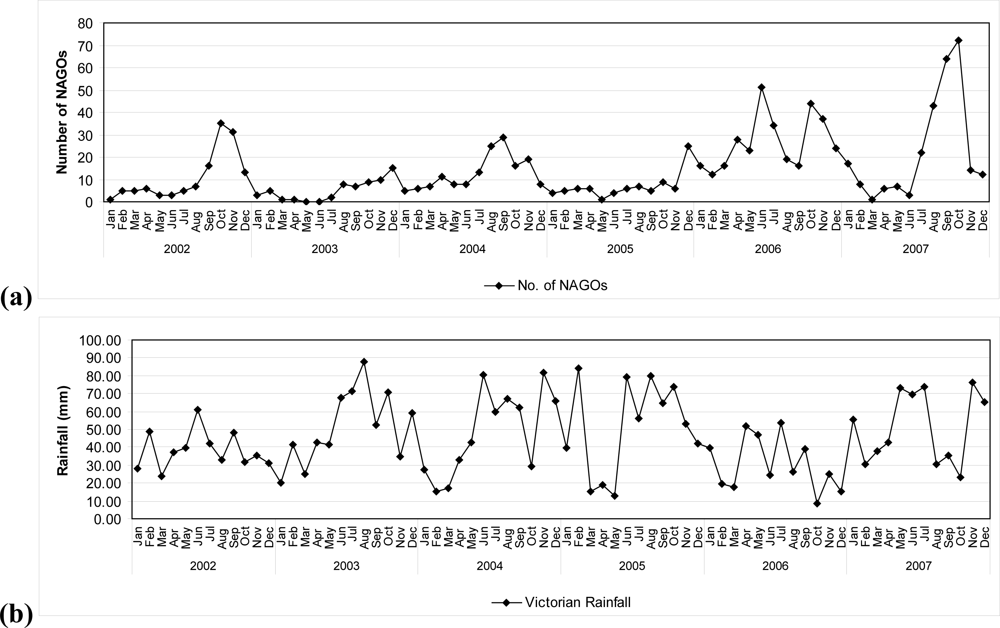The Incidence of Norovirus-Associated Gastroenteritis Outbreaks in Victoria, Australia (2002–2007) and Their Relationship with Rainfall
Abstract
:1. Introduction
2. Materials and methods
2.1. Outbreak Definition and Investigation
2.2. Laboratory Studies
2.3. Data Analysis
2.4. Statistical Analysis
3. Results
3.1. General
3.2. NAGO Incidence and Rainfall
3.3. The Time Lag between Highest Rainfall and NAGO Epidemics
4. Discussion
References
- Dowell, SF. Seasonal variation in host susceptibility and cycles of certain infectious diseases. Emerg. Infect. Dis 2001, 7, 369–374. [Google Scholar]
- Altizer, S; Dobson, A; Hosseini, P; Hudson, P; Pascual, M; Rohani, P. Seasonality and dynamics of infectious diseases. Ecol. Lett 2006, 9, 467–484. [Google Scholar]
- Bi, P; Zhang, Y; Parton, KA. Weather variables and Japanese encephalitis in the metropolitan area of Jinan city, China. J. Infect 2007, 55, 551–556. [Google Scholar]
- Nastos, PT; Matzarakis, A. Weather impacts on respiratory infections in Athens, Greece. Int. J. Biometeorol 2006, 50, 358–369. [Google Scholar]
- D’Souza, RM; Hall, G; Becker, NG. Climatic factors associated with hospitalizations for rotavirus diarrhoea in children under 5 years of age. Epidemiol. Infect 2008, 136, 56–64. [Google Scholar]
- Hashizume, M; Armstrong, B; Wagatsuma, Y; Faruque, ASG; Hayashi, T; Sack, DA. Rotavirus infections and climate variability in Dhaka, Bangladesh: A time-series analysis. Epidemiol. Infect 2008, 136, 1281–1289. [Google Scholar]
- Marshall, JA; Bruggink, LD. Laboratory diagnosis of norovirus. Clin. Lab 2006, 52, 571–581. [Google Scholar]
- Marshall, JA; Dimitriadis, A; Wright, PJ. Molecular and epidemiological features of norovirus-associated gastroenteritis outbreaks in Victoria, Australia in 2001. J. Med. Virol 2005, 75, 321–331. [Google Scholar]
- Bruggink, LD; Marshall, JA. Norovirus epidemics are linked to two distinct sets of controlling factors. Int. J. Infect. Dis 2009, 13, e125–e126. [Google Scholar]
- Bruggink, L; Marshall, J. Molecular changes in the norovirus polymerase gene and their association with incidence of GII.4 norovirus-associated gastroenteritis outbreaks in Victoria, Australia, 2001–2005. Arch. Virol 2008, 153, 729–732. [Google Scholar]
- Mounts, AW; Ando, T; Koopmans, M; Bresee, JS; Noel, J; Glass, RI. Cold weather seasonality of gastroenteritis associated with Norwalk-like viruses. J. Infect. Dis 2000, 181, S284–S287. [Google Scholar]
- Nygard, K; Torven, M; Ancker, C; Knauth, SB; Hedlund, K-O; Giesecke, J; Andersson, Y; Svensson, L. Emerging genotype (GGIIb) of norovirus in drinking water, Sweden. Emerg. Infect. Dis 2003, 9, 1548–1552. [Google Scholar]
- Hewitt, J; Bell, D; Simmons, GC; Rivera-Aban, M; Wolf, S; Greening, GE. Gastroenteritis outbreak caused by waterborne norovirus at a New Zealand ski resort. Appl. Environ. Microbiol 2007, 73, 7853–7857. [Google Scholar]
- Witlox, KJ; Karapanagiotidis, T; Bruggink, LD; Marshall, JA. The effect of fecal turbidity on norovirus detection by reverse transcriptase polymerase chain reaction. Diagn. Microbiol. Infect. Dis 2010, 66, 230–232. [Google Scholar]
- Witlox, KJ; Nguyen, TN; Bruggink, LD; Catton, MG; Marshall, JA. A comparative evaluation of the sensitivity of two automated and two manual nucleic acid extraction methods for the detection of norovirus by RT-PCR. J. Virol. Methods 2008, 150, 70–72. [Google Scholar]
- Yuen, LKW; Catton, MG; Cox, BJ; Wright, PJ; Marshall, JA. Heminested multiplex reverse transcription-PCR for detection and differentiation of Norwalk-like virus genogroups 1 and 2 in fecal samples. J. Clin. Microbiol 2001, 39, 2690–2694. [Google Scholar]
- Haugh, LD. Checking the independence of two covariance-stationary time series: A univariate residual cross-correlation approach. J. Am. Stat. Assoc 1976, 71, 378–385. [Google Scholar]
- Chatfield, C. The Analysis of Time Series An Introduction, 5th ed; Chapman & Hall: London, UK, 1996. [Google Scholar]
- Levine, DM; Stephan, D; Krehbiel, TC; Berenson, ML. Statistics for Managers Using Microsoft© Excel, 3rd ed; Pearson Education/Prentice-Hall International: Upper Saddle River, NJ, USA, 1997. [Google Scholar]

| Year | 3mth period of highest NAGOs | 3mth period of highest rainfall | Midpoint-midpoint time delay (mths) for rainfall |
|---|---|---|---|
| 2002 | Sep–Nov | May–Jul | 4 |
| 2003 | Oct–Dec | Jun–Aug | 4 |
| 2004 | Aug–Oct | Jun–Aug | 2 |
| 2005 | Oct–Dec | Jun–Aug | 4 |
| 2006a | May–Jul | May–Jul | 0 |
| 2006b | Oct–Dec | May–Jul | 5 |
| 2007 | Aug–Oct | May–Jul | 3 |
© 2010 by the authors; licensee Molecular Diversity Preservation International, Basel, Switzerland. This article is an open-access article distributed under the terms and conditions of the Creative Commons Attribution license (http://creativecommons.org/licenses/by/3.0/).
Share and Cite
Bruggink, L.D.; Marshall, J.A. The Incidence of Norovirus-Associated Gastroenteritis Outbreaks in Victoria, Australia (2002–2007) and Their Relationship with Rainfall. Int. J. Environ. Res. Public Health 2010, 7, 2822-2827. https://doi.org/10.3390/ijerph7072822
Bruggink LD, Marshall JA. The Incidence of Norovirus-Associated Gastroenteritis Outbreaks in Victoria, Australia (2002–2007) and Their Relationship with Rainfall. International Journal of Environmental Research and Public Health. 2010; 7(7):2822-2827. https://doi.org/10.3390/ijerph7072822
Chicago/Turabian StyleBruggink, Leesa D., and John A. Marshall. 2010. "The Incidence of Norovirus-Associated Gastroenteritis Outbreaks in Victoria, Australia (2002–2007) and Their Relationship with Rainfall" International Journal of Environmental Research and Public Health 7, no. 7: 2822-2827. https://doi.org/10.3390/ijerph7072822




